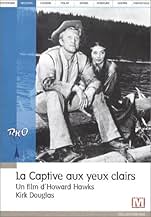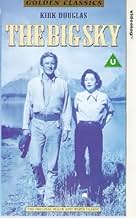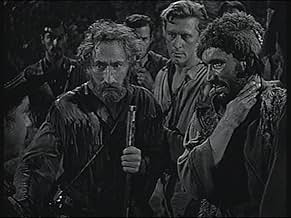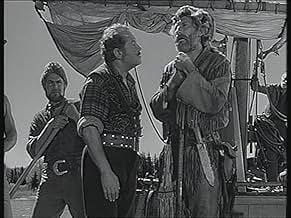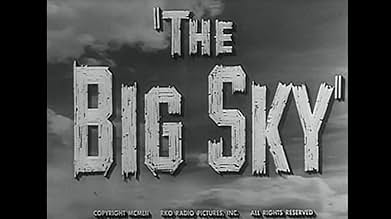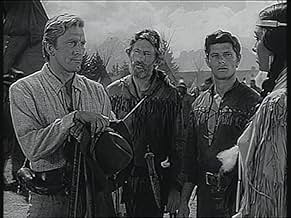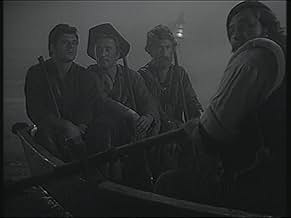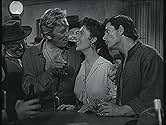El éxito del viaje se centra en mantener con vida a la joven india y a ellos mismos para completar el comercio con los Blackfeet.El éxito del viaje se centra en mantener con vida a la joven india y a ellos mismos para completar el comercio con los Blackfeet.El éxito del viaje se centra en mantener con vida a la joven india y a ellos mismos para completar el comercio con los Blackfeet.
- Nominado a 2 premios Óscar
- 3 nominaciones en total
- Blackfoot Dancer
- (sin créditos)
- Horse Trader
- (sin créditos)
- Tavern Patron
- (sin créditos)
- Tavern Proprietor
- (sin créditos)
- Tavern Patron
- (sin créditos)
- Jailer
- (sin créditos)
- Blackfoot Subchief
- (sin créditos)
- Pascal
- (sin créditos)
"The Big Sky" was filmed on location, and this alone makes the film worth watching, for the splenor of the Snake River and Grand Tetons, where the film was actually shot, is breathtaking.
But "The Big Sky" has other virtues which raise it far above the average "scenic". First, is the multi-layered plot. Besides the story of an enterprise, "The Big Sky" is about how men, in a time long past, interacted, when their differences were subordinated to a higher purpose. Second, is director Howard Hawks, whose trademark "naturalistic dialogue" technique is put to wonderful use here. Hawks works on complex relationships - male and female, "Frenchie" and Anglo backwoodsmen, Native Americans and whites - like a conductor a symphony. Third, and perhaps most touching, is the tale of male bonding not only among the group of men, but one-on-one between Jim Deakins, played by Kirk Douglas, and Boone, his young sidekick, played by Hawks protegé Dewey Martin. There's a nice, touching story toward the end.
This is a shamefully underrated film. Superb cinematography (Oscar nominated), rich plot, flawless casting (Arthur Hunnicutt nominated for Best Supporting Oscar), masterful direction, make "The Big Sky" a true classic.
- jacksflicks
- 11 mar 2000
- Enlace permanente
Argumento
¿Sabías que…?
- TriviaWhile shooting Río Rojo (1948), there was a scene that director Howard Hawks unsuccessfully urged John Wayne to do. It involved his getting a finger mangled between a saddle horn and a rope, resulting in Walter Brennan's amputating it. Hawks reportedly told Wayne, "If you're not good enough, we won't do it", but Wayne wouldn't do it. According to Hawks biographer Todd McCarthy, Hawks did get Kirk Douglas to do that scene in this film, and it came off so funny that Wayne later declared to Hawks, "If you tell me a funeral is funny, I'll do a funeral."
- ErroresJim expresses amazement at the size of St. Louis. However, he had just come from Louisville, which in 1832 was about twice the size of St. Louis, so it should not have been a source of such astonishment.
- Citas
Zeb Calloway: Blackfeet... proud injuns. They ain't gonna let no white man spile their country. The only thing they'a feared of is a white man's sickness.
Boone Cardell: What's that?
Zeb Calloway: Grabs. White men don't see nothing pretty unless they want to grab it. The more they grab, the more they want to grab. It's like a fever and they can't get cured. The only thing for them to do is to keep on grabbin' until everything belongs to white men and then start grabbin' from each other. I reckon injuns got no reason to love nothing white.
- Créditos curiososInstead of the traditional RKO morse code sound, the film's opening theme music is played over the RKO radio tower image. Later, a title card is displayed explaining the premise of the story.
- ConexionesReferenced in Pour la peau d'un flic (1981)
Selecciones populares
Detalles
- Fecha de lanzamiento
- País de origen
- Idiomas
- También se conoce como
- Horizontes salvajes
- Locaciones de filmación
- Productoras
- Ver más créditos de la compañía en IMDbPro
Taquilla
- Presupuesto
- USD 2,000,000 (estimado)
- Tiempo de ejecución2 horas 20 minutos
- Color
- Relación de aspecto
- 1.37 : 1
Contribuir a esta página

















